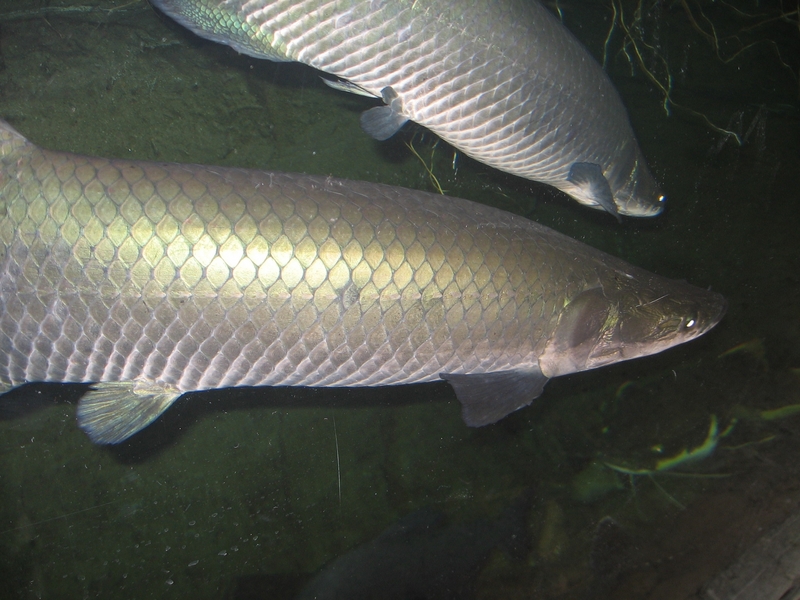|
Pirarucu / Giant Arapaima (Arapaima gigas) - Wiki
| 제목: | Pirarucu / Giant Arapaima (Arapaima gigas) - Wiki
| |

| 해상도: 2048x1536
파일크기: 1570330 Bytes
촬영일: 2006:04:18 13:27:47
사진기: Canon PowerShot A510 (Canon)
F number: f/2.6
Exposure: 1/60 sec
Focal Length: 186/32
등록시간: 2007:01:02 02:02:10
|
ERROR : Server Busy(-1105)
ERROR : Server Busy(-1105)
Pirarucu / Giant Arapaima (Arapaima gigas) - Wiki
Arapaima
From Wikipedia, the free encyclopedia
[Photo] Pirarucu (Arapaima gigas). Date 2006-04-18. Author Ginkgo100 http://commons.wikimedia.org/wiki/User:Ginkgo100
The arapaima, piracucu, pirarucu, or paiche (Arapaima gigas) is a South American tropical freshwater fish. It is listed in the Guinness Book of World Records as the world's largest freshwater fish, reportedly with a maximum length in excess of 3 m (9.8 ft.) and weight up to 200 kg (440 lb.), although these reports have been disputed. As one of the most sought after food fish species in South America, it is often captured by spearing for export, and, consequently, large arapaima of more than 2 m are seldom found today.
The diet of the arapaima consists of other fish or even small animals, including birds. This fish is able to survive extensive drought periods by gulping air and burrowing in the mud or sand of the swamps.
The arapaima has also been introduced for fishing in Thailand and Malaysia. It is also considered an aquarium fish, although it obviously requires a large tank and ample resources.
Fossils of arapaima or a very similar species have been found in the Miocene Villavieja Formation of Colombia.
The tongue of this fish is known to have medicinal qualities in South America. It is dried and combined with guarana bark, which is grated and mixed into water. Doses of this are given to kill intestinal worms.
Reproduction
Due to the geographic range that arapaima inhabits, the animal's life cycle is greatly affected by the seasonal flooding that occurs. Half of the year the arapaima experiences an abundance of water, which is a benefit to these aquatic organisms; however, the other half of the year the arapaima experiences drought conditions. The arapaima has adapted to this great fluctuation in many aspects of its life, including reproduction. The arapaima lays its eggs during the months of February, March, and April when the water levels are low. They build a nest approximately 50 cm wide and 15 cm deep, usually in sandy bottomed areas. As the water rises the eggs hatch and the offspring have the flood season to prosper, during the months of May to August. Therefore, the yearly spawning is regulated seasonally. The arapaima is a mouthbrooder.
Economic Importance for Humans
The arapaima is hunted and utilized in many ways by local human populations. Arapaima are harpooned or caught in large nets and the meat is said to be delicious. Since the arapaima needs to swim up to breathe air, traditional arapaima fishers often catch them by first clubbing them and then harpooning them dead. One individual can yield as much as seventy Kilograms of meat. In addition, the arapaima's bony tongue is often used to scrape cylinders of dried guarana, an ingredient in some beverages, and the bony scales are used as nail files. This animal also appears in the pet trade, although to keep a arapaima correctly requires a large tank and can prove quite difficult.
Trivia
In the Nintendo GameCube videogame Animal Crossing and subsequent sequels, the arapaima is the third rarest catch.
http://en.wikipedia.org/wiki/Arapaima
| The text in this page is based on the copyrighted Wikipedia article shown in above URL. It is used under the GNU Free Documentation License. You may redistribute it, verbatim or modified, providing that you comply with the terms of the GFDL. |
|
댓글 |
|---|
| | 손님 |
|
Scientific Name: Arapaima gigas (Schinz, 1822)
Common Names: Arapaima, Pirarucu, Giant Arapaima; [French] Arapaïma, Paiche
Synonyms: Sudis gigas Schinz (ex Cuvier), 1822 |
^o^
동물그림창고 똑똑전화 누리집
^o^
|
|
|

